Five tips to create an SEO-friendly FAQ page

Search engines and people love the Frequently Asked Questions (FAQ) pages. Having a well-written FAQ section on your website is a great way to show online customers that you care about their experience and get you found from outside your website, directly responding to the needs of your audience and their search queries.
For good reason, voice search is becoming increasingly popular. Google reports that 20% of searches are voice related. So, it cannot be denied that people are looking for easier and faster ways to get answers to their questions.
FAQ content can drive a bunch of highly targeted traffic to your website. In many cases, business owners have to use it as a winning content marketing strategy. Here are some reasons why you should create an SEO-friendly FAQ section:
- It helps refund and customer service inquiries.
- It attracts potential customers and builds trust in your business.
- It improves your SEO rankings because Google values that your website is focused on helping people to get all the information to take an educated decision on your product.
So, if you want to get the most out of your FAQ resource, you should build it right. Here are five ways to make it both focused and comprehensive.
1. Collect relevant FAQs
Before creating your FAQ page, it’s crucial to raise the right questions to educate your online customers about your service or product and generate demand. It takes a thorough and continuous question research, a lot of planning, and a little strategic work.
If you have a support center or customer service reps – frontline employees that are always getting bombarded with questions, you can easily find out what questions your customers regularly ask. They are valuable sources of information for collecting questions and giving answers to multiple people at the same time.
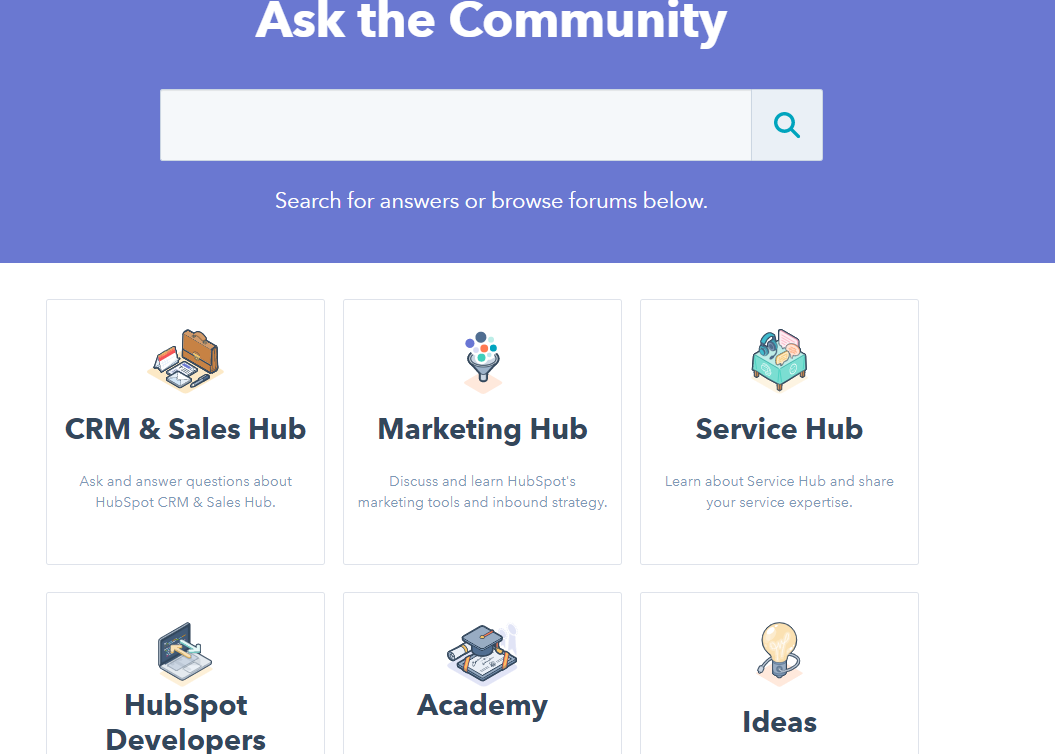
To take this further, collecting customer and visitor feedback is a good practice to improve any business. Online survey tools like Survey Anyplace helps you create an online survey questionnaire, identify pain points that your target audience has, and supplement your content with unique data and insights.
Keyword research tools like SE Ranking lets you detect the most popular keywords people are using around the web. The tool uses a separate algorithm that generates the most common words in your niche questions together with search volume, traffic cost, keyword effectiveness index (KEI), and other parameters. You can easily filter and export your results so it can be saved.

Source: SE Ranking
While Google highlights a lot of insight into the most popular questions, forums like Quora or Reddit will bring up the most trending questions people are interested in at this very moment. The best way to find questions is to follow a particular category and check for new questions on a regular basis. There is also an additional benefit of making more meaningful connections out there and position yourself as a niche expert.
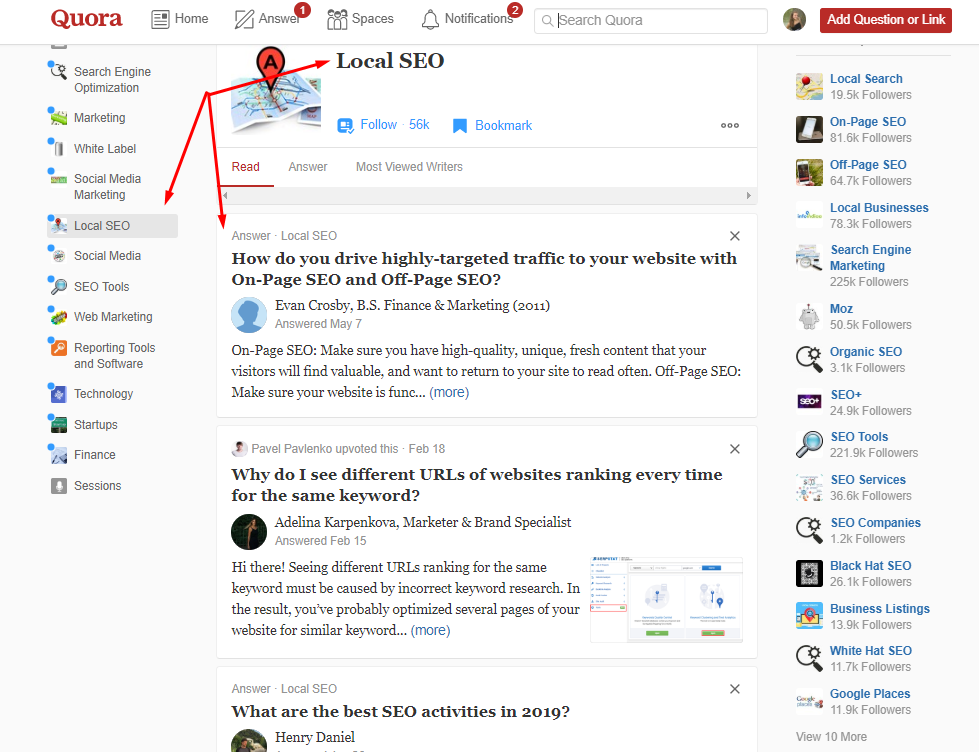
Check out your competitors’ FAQ pages, product reviews for items in your niche, and look closer at what they are doing, and what questions they answer that you haven’t. Have you heard these questions from your consumers before? Adopt their best experiences and improve your FAQ page.
2. Implement structured data
Adding structured data to your FAQ page is a good way to become more visually appealing in the SERP, get a higher average click-through rate, and pull ahead of your competitors in your niche. Fortunately, Google recently added support for FAQ structured data in search and Google Assistant.
By implementing this structured data, you can make your content eligible to show questions and answers directly on Google Search and the Assistant. Notice that FAQ can be used for single pages that provide official questions and answers.
You should not be confused with Q&A Page markup that is designed for sites like forums, Quora where users can submit answers to questions. You can find out more about this markup in the FAQ developer.
Here’s how it looks like in the search.
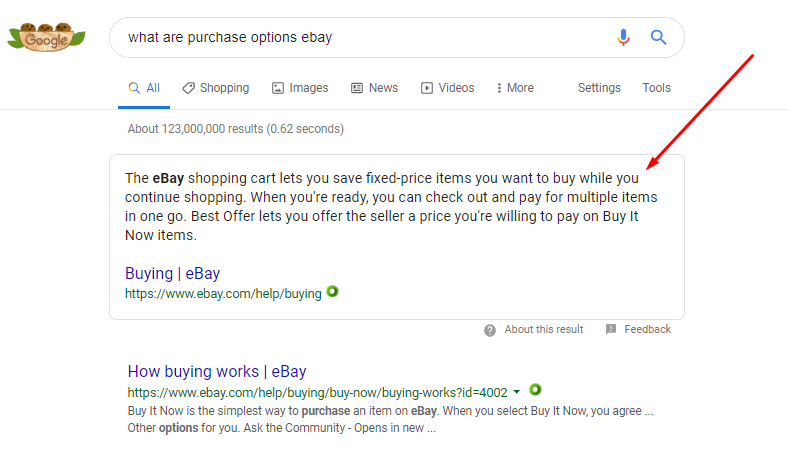
To learn more about implementation details for Google Assistant, you can visit a FAQ Action with markup.
To track any FAQ issues and search appearance, Google included a new enhancement report in Search Console. It displays all warnings, errors, and valid items related to your FAQ pages.
3. Think visually
Sometimes a picture is a better way to explain touch concepts, grab attention, and make the learning process more fluid. Don’t limit your answers to text. Use stunning and well-designed images, graphics, illustrations or videos to add more visual appeal to your FAQ page and make it easier for visitors to receive clear answers to their questions.
For example, if you’re giving instructions for executing a specific process, or are providing details about how to use a certain feature of one of your services, images, charts, graphics, and screenshots can guide customers through it step-by-step. They simply help people break up big chunks of text and improve their comprehension.

4. Build a brilliant navigational structure
No matter how well-written your FAQ section is, it’s not going to get to your prospects if users can’t find it or even navigate it. Giving your FAQ section a structure will improve customer satisfaction, loyalty, and SEO for the entire website.
If you have longer FAQ pages, many categories, and subcategories, search functionality will make it easier for users to find answers instantaneously. It keeps them from clicking through your knowledge base to find the right question. Notice that the FAQ search is distinguished from the general search option of the website. Consider this difference to shorten the number of search results and provide the right solutions for your customers.
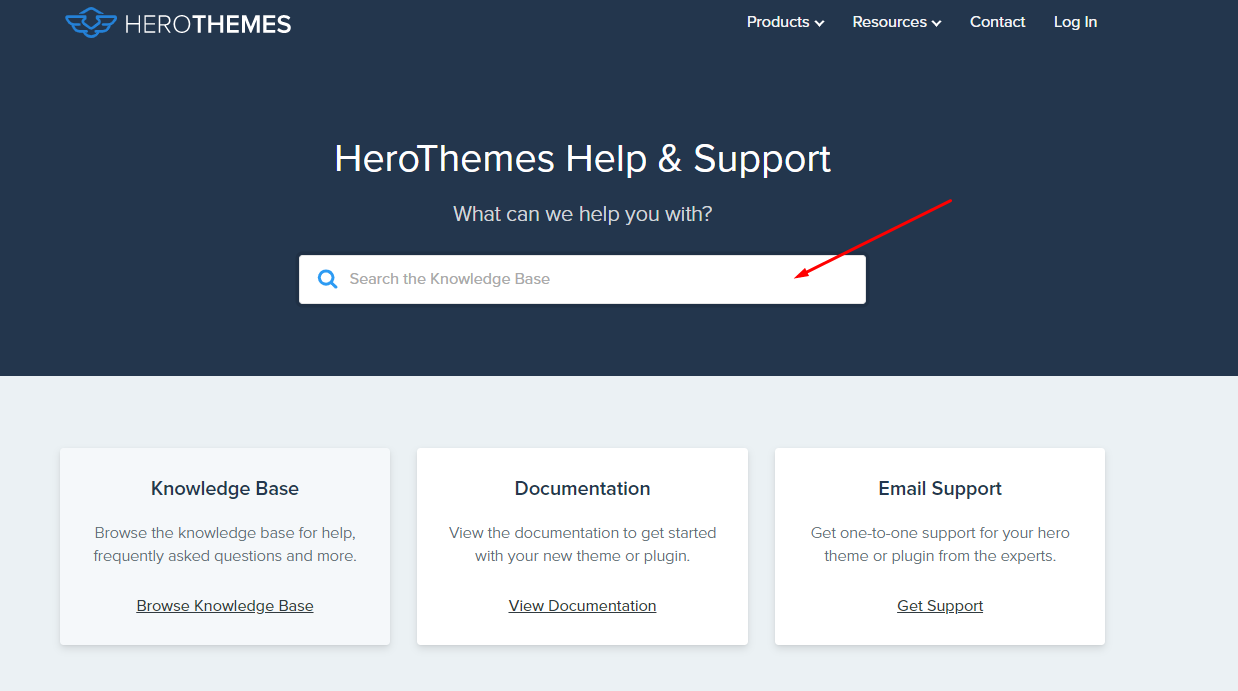
Source: HeroThemes
It’s a good idea to divide questions into categories and lead to informative subheadings. For example, shipping, sizing, features, and other such relevant details – and in case you provide a long list of questions.
In the image given below, Pepper offers the FAQ page that is intuitively categorized and easy to navigate.
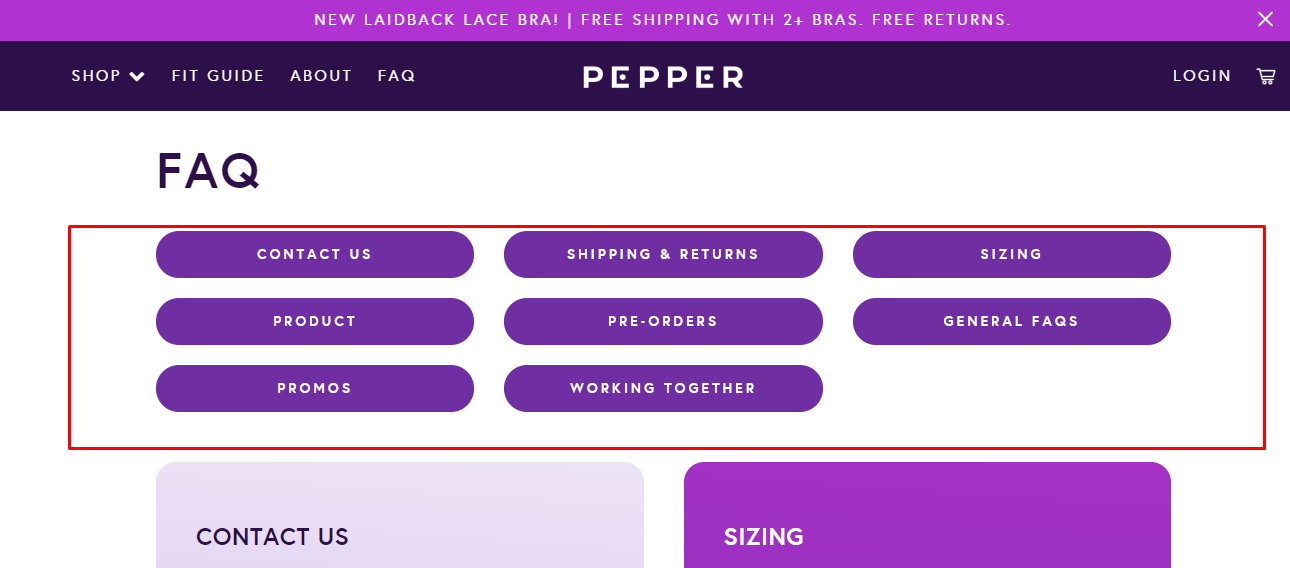
Source: Pepper
To reduce your page to a more manageable size, you can list only the questions and include links to take readers to the answers. It’s great for SEO as it drives traffic to many pages on your site and causes high spikes in page views that Google measures to decide how valuable your content is. If you want to optimize your FAQ section for search queries, this structure can be a good fit for that.
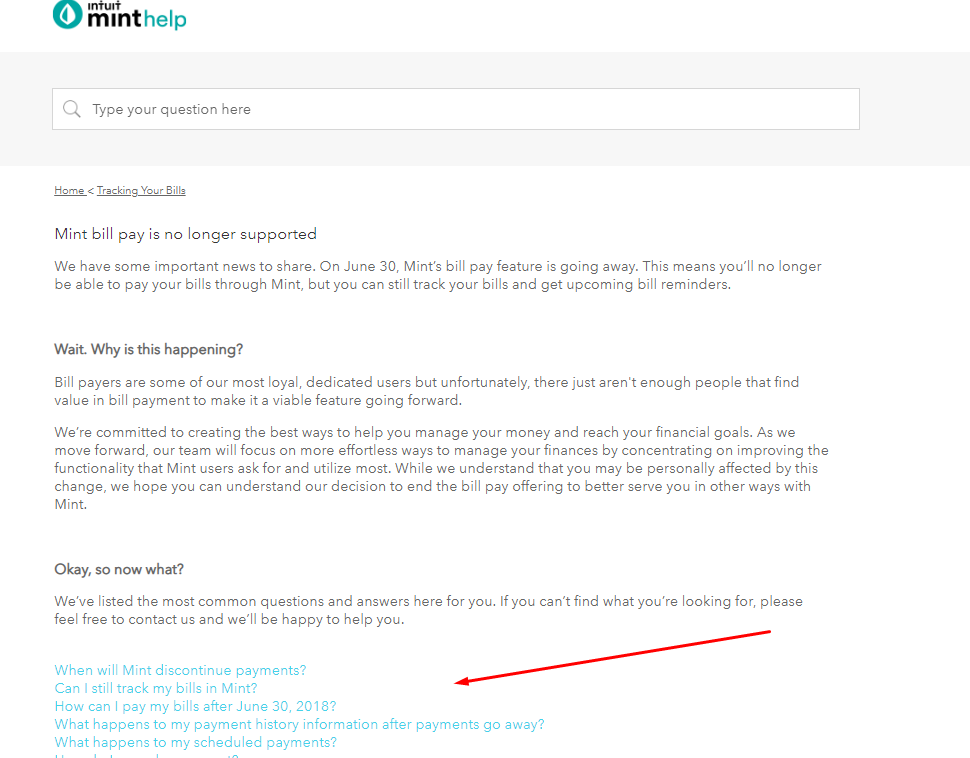
Source: Mint.com
Make short SEO-friendly URLs for each FAQ post to simply direct customers to exactly the right answer, build trust in the searcher and easily share useful information with others. Use popular social media to spread the word about your FAQ page.
5. Check analytics on a regular basis
Once you’ve created your FAQ page, you should start with the analytics of your website in order to see whether the page is getting traffic and ranking for useful keyword phrases.
Are users visiting your FAQ page or are they going by? How long do they stay? Where do they go after looking at the FAQ page? What paths are they taking? Getting these meaningful and actionable insights, you can add some minor changes or rework your page to better direct visitors to the FAQ section.
To get advanced web analytics, you can start a quick overview of a page in Finteza. The tool features full-cycle data management to find out whether your marketing campaign has reached desired targets, which channels and sources generate the highest traffic and how conversion rate can be further improved.

Source: Finteza
Checking analytics regularly will help you fine-tune your FAQ pages and other web pages within your site.
Wrapping up
Generally, an FAQ page looks like an afterthought for many websites. But if used strategically, it can give you much value in different ways, from reducing purchase anxiety to easing the burden on support teams.
What’s more, you’ll be able to educate your teams and yourself while creating a list of FAQ questions, and offer a better service or product on the go.
Are you making the most of your FAQ page? What tactic works well for your business? Share your thoughts and experiences in the comments section.
Related reading
When using nontechnical techniques, sound marketing principles ultimately lead to increased web rankings. Simple techniques to adopt for Google visibility.
It’s always best to have tools and processes in place. Obviously, you don’t need anything fancy. You could start by setting up Google Alerts.
Your search engine marketing success hinges upon your site’s UX. Two elements of UX that are particularly relevant to SEO.
How marketers can take the lead with revenue optimization teams
Most marketers are equipped with copious amounts of data that help us understand our customers, create meaningful messaging that resonates with our audience and drives the business outcomes we need to achieve our goals. Marketers also have the ability to translate different trends across customers and prospects such as strong lead generation sources, common themes, objection trends and overall responses to different campaigns. But, many organizations operate in siloes, making it difficult to share these data points with the necessary people.
A solution? Establish a revenue optimization team to bring together the key internal players in your organization to improve alignment and ultimately, drive more revenue.
Marketers and sales need to track the same goals
Thanks to the amount of valuable information accessible through our martech stacks, marketers can — and should — play a critical role in establishing a customer-centric revenue optimization team.
“Revenue optimization starts with the idea of putting the customer in the center of every interaction an enabling everyone to align around the customer to generate value in every interaction,” said Patrick Morrissey, chief marketing officer of customer revenue optimization platform, Altify. And according to Morrissey, marketers should play a critical role as part of the revenue team, and are best positioned to lead the charge. For many marketers, this requires a shift in thinking about our revenue contributions.
“From a marketing perspective, thinking about the fundamental outcomes, marketers have to start thinking of themselves as part of the revenue team,” said Morrissey. “This intersection presents an opportunity for marketers who are generally better communicators to become the translation mechanism for an entire team. Instead of tracking pipeline, marketers need to track revenue in closed/won business along with the sales team.”
The shift in mindset expands past the marketing team, however. According to Jenn DiMaria, senior manager of client services at marketing automation solution provider Digital Pi, the shift in mindset needs to be organizational. “Marketing is often viewed as a cost center, but in reality, other teams are lusting after the tools and data we have access to,” said DiMaria. “Aligning a revenue team creates opportunities for marketers to improve accessibility to the data and help bridge gaps with other parts of the organization.”
Marketers, get closer to the customer
Marketers tend to be far removed from any interactions with customers, but it is extremely valuable to engage face-to-face with customers. After all, marketers understand that relationship-building is key to retaining customers. According to Morrissey, marketers need to put themselves in the shoes of the customer in order to understand their challenges.
“Marketers should focus on how we can get out of our own way and put ourselves in the shoes of the customers,” said Morrissey. “Going on the road to meet with salespeople and sit with customers will help marketers better understand the market, the broader changes in technology and fundamentally how to help customers succeed, personally and professionally.”
“Marketers need to have some real-world customer experience, explained Mary Ngai, founder of Connector42 and head of analytics and technology at RI. “Even if marketers are listening on sales calls, it can be incredibly insightful in grasping a better understanding of their needs.” Ngai also recommends that marketers attend customer site visits during ongoing projects or sales deals to increase visibility into accounts.
In addition to more face time with customers, Morrissey recommends that marketers lead internal account reviews and deal reviews with the sales and customer success teams. Regularly reviewing the accounts with members of different parts of the organization will expose different issues and areas that can be addressed by the necessary members of the revenue optimization team. Working with customer success can also bring to light what some of the daily challenges and successes the customer experiences — valuable insight for marketers as they developing retention campaigns to drive renewals.
Leading the path to revenue optimization
Revenue optimization teams present an opportunity for marketers to leverage their communication, analytical and creative skills to improve holistic marketing efforts in coordination with other internal departments.
“Marketers have proven that we can lead revenue optimization teams as we typically bear the brunt of the responsibility when it comes to acquiring new leads and we have to track our efforts,” said DiMaria. “Also, tools that have entered the market in the past ten years have made this possible.”
The concept of implementing a fundamental shift in thinking may seem overwhelming, but the long-term benefit is streamlined efforts across your organization and consistent communication around prospect and customer activities.
“If you think about the customer journey, we’re all trying to get a numeric view of the customer — BDRs are measured by the total number of call they make and are concerned with propensity-to-buy data,” said Morrissey. “Marketers are providing that data, creating segments and determining what funnel to put a prospect in. Then we talk about deal size or ACV, then finally we’re just an NPS score. Marketers are the ones who can best translate this into plain English, for everyone to understand.”

How to run a successful competitor-focused paid campaign

One of the biggest advantages of running a paid search campaign is the ability to bid on keywords that would be difficult (if not impossible) for your website to rank for organically.
The best example of this is bidding on competitors’ brand or product names. For example, if you’re in the athletic shoe/apparel industry, you’d probably want to bid on Nike or UnderArmour branded terms. So, if you’re not running any competitor focused campaigns right now, you are definitely missing out.
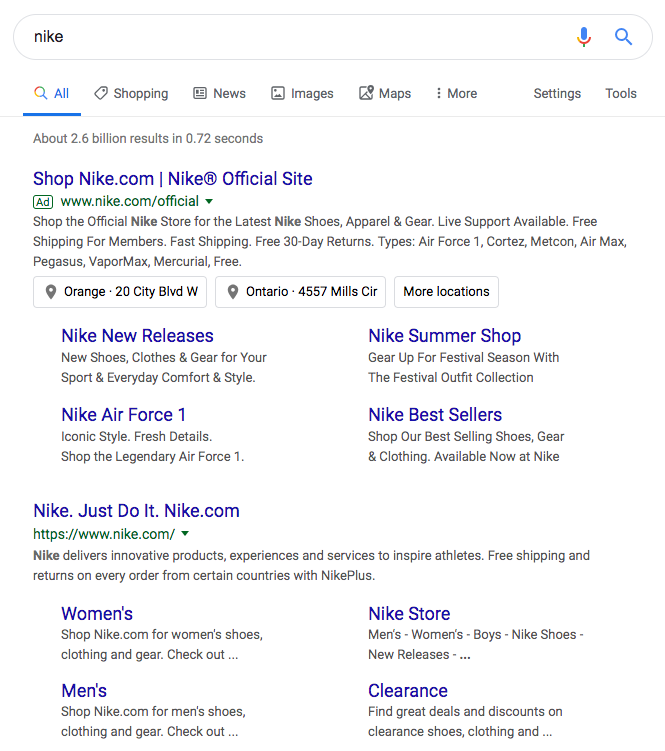
But it doesn’t have to be that way. Here are five steps to set up and run a successful competitor-focused SEM campaign.
Step one: Do your research
First things first, you’ll want to go through a current list of competitors and perform preliminary keyword research on each of them, one-by-one.
Preliminary research should cover average monthly search volume, the number of relevant keyword variations, estimated keyword bids, and any potential conflicts or double-meanings – a classic example would be “Apple” the company or “apple” the fruit) within the keyword phrases you are considering targeting. This should include not only the competitors’ brand names but also all product name(s) that your company competes with directly. You’ll want to repeat this step for every competitor on the list.
Step two: Choose your competitors wisely
After going through the research portion mentioned in step one you’ll want to narrow down your list and focus on just your top three competitors. Why only three? To ensure your messaging is tightly focused around each competitor and that your key differentiators against each specific product can be clearly communicated in both the ad copy and on a custom landing page (more on landing pages in a minute). So how do you determine which three competitors to focus on?
After completing step one you should have the quantitative data needed to determine if it’s worth targeting certain keywords related to a specific competitor or product. But don’t just go off of the numbers alone. You’ll also want to account for strategic business reasons that could outweigh factors such as monthly search volume or estimated bid numbers. For example, your company is planning to launch a new product in the coming months and wants to hit the ground running.
If everything still looks good at this point then you can continue with your standard keyword research/selection process. But be sure to keep the following in mind:
- Use exact match if a brand or product name has an abnormally high average monthly search volume.
- Include all relevant brand/product name variations as well as common misspellings.
- Pay close attention to the following queries – “alternative to [your competitor]”, “[your company name] competitors”, or “[your competitor #1] vs [your competitor #2]”. You’ll likely want to include these phrases in your campaign.
Step three: Landing pages (the bread and butter)
Let’s face it, landing pages are your workhorse. They can make or break your campaign. Because of this, I always recommend creating a unique landing page for each competitor. You may be thinking, that’s going to take a lot more time, is it really worth it?
The answer is yes and the reasons are simple, relevance and context. Relevance is important because you’re going to be bidding on keywords with the intention of “stealing” traffic away from your competitors. And context is critical because if the prospect’s intention was to find out more about one of your competitors, you are steering them off their original course. This is fine but you need to make it clear how you’re adding value to their research efforts.
With this in mind, let’s go over a few specific recommendations when it comes to creating engaging competitor-focused landing pages.
First, it’s important to immediately convey that the content is all about “You vs. Specific Competitor X”. Since people are going to be actively searching for information on Competitor X, you’ll not only want to show them the info they’re most likely looking for but also how your company stacks up against said info. So, for example, by creating a basic three column table with the first column listing out the features/functions, the second showing how your company performs against that feature/function and the third how your competitor stacks up. It’s an easy, visual way to convey the focus of the page and provide the visitor with the information they were probably searching for in the first place.
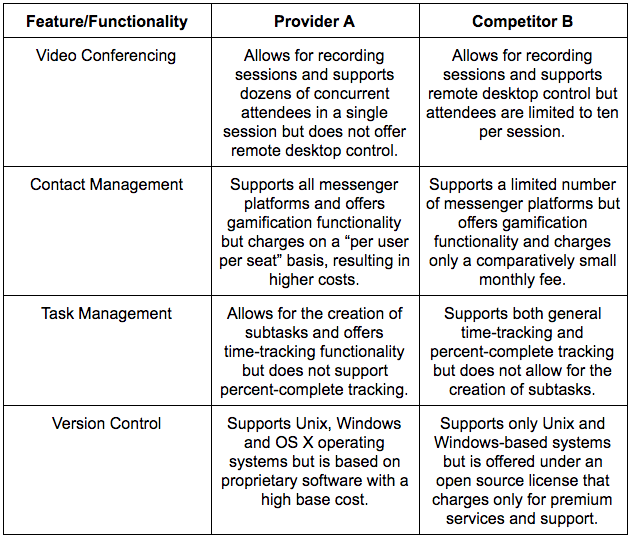
Ideally, you want to make sure the content is designed to give the visitor a fair comparison of you and your specific target competitor. This is particularly true for certain queries such as, “alternative to [your competitor]”.
Step four: A/B testing from the get-go
Marketers are constantly told that they need to be doing more A/B testing. But is this overkill? Yes and no. You definitely want to be following the ABT (Always Be Testing) rule when it comes to running any digital campaign. But too much testing can eat up time and resources that could be spent on other campaigns or initiatives.
So, to help mitigate, you’ll want to take steps to streamline testing right off the bat. For example, don’t use your competitor’s name directly in the ad copy itself. Depending on your industry and level of competition this might not be an issue (local “mom & pop shops” probably haven’t trademarked their business name). However, for any decent size company, you’ll have to assume their name will be trademarked, which means your ad will get rejected for using a trademarked term. To save time it’s best to avoid using brand names in your copy.
The testing in your ad copy should focus on testing different key differentiators in relation to a specific competitor. The reason for this is simple, you won’t be able to include every single differentiator in your copy due to character count restrictions. So instead you have to focus on the most compelling ones.
Note: These differentiators should be included on the corresponding landing page as well.
Lastly, when running this kind of A/B test you’ll want to make sure to change only one element at a time. If you’re changing more than one element at a time it can be difficult to determine the true cause of any fluctuation in performance. For example, if you change headline one in an ad, you’ll want to keep description one and the CTA consistent.
Step five: Quality over quantity
Last but definitely not least, let’s talk about leads, you know, the reason we’re all running these campaigns in the first place.
Too many companies focus on the wrong thing when it comes to leads – Raw numbers. What companies really need to focus on is quality. Revolutionary, I know. But how can you assess quality?
First, start by looking at the following information – Was a work email provided? Did the prospect provide their title? If so, does it fall in line with your target audience? Does their company match your target company revenue/size/industry targets?
The answers to these questions will tell you if your campaign is on the right track, or if adjustments need to be made. They will also provide valuable context, something the raw number of new prospects generated won’t be able to.
With that said, there is still value in continuing to track and report on both, the total number of new prospects (which is quantity) as well as the number of designated “ideal fit” prospects (which is quality). Taken together, these metrics will help you to determine how successful your campaign has been.
Running a successful competitor focused paid search campaign can be tough. From the setup to the ongoing optimization and the reporting, it’s non-stop data gathering, analysis, copywriting, and A/B testing. But if you follow these five steps, it should help to streamline the process and make it easier to manage.
Related reading
We neglect non-brand CPC advertising because, clients think it’s too expensive, too competitive, and a lot of work for a little payoff. How to make it work?
When using nontechnical techniques, sound marketing principles ultimately lead to increased web rankings. Simple techniques to adopt for Google visibility.
It’s always best to have tools and processes in place. Obviously, you don’t need anything fancy. You could start by setting up Google Alerts.
Constant Contact launches e-commerce enhancements
Constant Contact announced an integration with WooCommerce is now available to merchants using both platforms. Constant Contact also revealed enhancements to its current integration with Shopify.
Features such as email automation, personalization, segmentation and triggered emails will be available to customers who connect their WooCommerce platform to their Constant Contact accounts.
Shopify customers can expect more personalization capabilities and a better view of customer data, including order activity and customer revenue. Additional segmentation features will also be available. Constant Contact will also provide live marketing support for its customers.
Why we should care
According to Accenture, 91% of consumers are more likely to shop with brands who recognize them by name, remember their preferences and provide them with relevant offers. These integrations bring more advanced email marketing capabilities to merchants. The ability to tie together data from e-commerce platforms into the email marketing platform, if done correctly, could generate more value for smaller merchants, in particular.
“Creating a marketing strategy for e-commerce is not just about how to get more sales,” said Luca Sechi, vice president of corporate strategy at Constant Contact., “but also making the customer experience better, generating repeat business, creating brand awareness, and building lasting customer relationships.”
More on the news
- Small businesses using WooCommerce will be able to sync contacts and send automated emails to first-time customers, purchasers in the last 30 days, repeat customers and more.
- The Shopify integration will allow customers to define segments with additional data including email open and click activity and contact details such as location and birthday month.
- Constant Contact is also offering marketing support to customers by phone or online chat.

Who’s poised to win the brewing v-commerce wars?

While Google is an obvious “horse to bet on,” ubiquity, UX and utility will dominate the voice-search innovation race in 2020 and beyond.
An old prediction that half of all internet searches will be carried out via voice by 2020 does not look like it’s on track to be a reality, despite making it into Mary Meeker’s Internet Trends 2016 Report.
Back then, in 2014, Baidu had just hired away Google Brain mastermind Andrew Ng to head up a massive deep learning project to help it beat Google in a new, non-text search race.
About five years later, China’s top search engine, Baidu, is still competing in the race to win in voice search dominance and secure the healthiest share of the lucrative market for voice commerce (v-commerce) that pundits predict lies ahead. In January during the annual C.E.S. show, Baidu said its answer to Alexa and Siri was already on 200 million devices. At that time, more than 100 million devices pre-installed with Alexa had been sold, and Google forecast it expected to have one billion devices with its Assistant onboard by the end of that month.
Just last month, a Harvard Business Review article by Bret Kinsella explored the race to own voice search and, in turn, the best v-commerce experience amongst the global tech giants:
“You can only understand the voice platform wars by first recognizing that voice assistants, specifically, represent both a platform and user interface (UI) shift comparable to the web and smartphones. This scenario both excites and frightens the leading tech companies that carved out enviable positions in the earlier web and smartphone platform wars.”
Google’s advantages and core challenge to winning voice search
Of the tech giants on our “home team” that are based in the U.S., Google seems like the most obvious company (versus Amazon, Microsoft or Apple) to bet on to eventually win and dominate in a new voice search age that powers v-commerce and corresponding ad dollars to support it.
For one, it currently owns more than 90 percent of all search traffic.

Its brand is synonymous with search today. “Just Google it,” as we all constantly say. Google’s ascendance as the dominant search engine sets it up well to be a similar authority and leader in voice search. Also, its Google Maps that is the go-to navigation app used by about 70 percent of smartphone owners, sets it up to help on-the-go users find and buy needed products nearby — from an umbrella in a rainstorm to the closest place to get some work done in a nearby internet cafe. When it comes to smartphones, Google’s Android OS continues to dominate the global market with about 86 percent of current market share compared to about 14 percent using Apple iOS, per the latest numbers from IDC.

But, the future of voice search and v-commerce is not just all about smartphones. Juniper Research predicts there will be nearly eight billion digital voice assistants in use by 2023 compared to 1.5 billion assistance devices today.

The fastest growing category is connected TV-based voice assistants, and others will “live” in refrigerators, cars, smartwatches and more. The tech giants vying to own the future of v-commerce need to think about a ubiquitous presence across all types of smart devices that will be coming to market. Our virtual assistants are independent of smartphones or speakers. They can operate and serve us in many places.
It’s too early to rule out Amazon and Apple from winning the v-commerce race yet
In comparison to Google, both Amazon and Apple are less open in comparison. Both companies rely on walled gardens that provide distinct advantages and disadvantages.
For Apple, its focus on privacy for users has been popular with consumers and regulators, but when it comes to voice search paired with location-based marketing, Apple’s push to turn off access to location beacons in mobile apps via latest iOs 13 will limit how it plays in a world of v-commerce because its users won’t be able to ask their iPhone where the closest Starbucks is to them anymore. Apple’s approach also won’t lend itself to delivering a future of highly relevant, personalized offers that we’ve seen in future-forward SciFi movies such as “Minority Report.”
When it comes to eCommerce, no other player dominates like Amazon does today. Amazon has more than 80 percent of conversions compared to other eCommerce sites across a diverse set of product categories, according to Jumpshot. The planet’s largest retailer, a title that Amazon took from Walmart last month, has also surpassed Google in terms of where product searches start from on the internet. Yet, so far, Amazon has trailed behind Google in terms of an easy experience and accessibilty to bring users into a voice-activated world across devices.
Ubiquity across devices, the best UX and shopper utility will lead to dominance
The ultimate winner, in the end, will be the tech platform that delivers the ability to use voice search across the internet and the maximum number of devices. It’s also critical to deliver the simplicity of experience and speedy results that helped Google become the long-standing king of the hill for internet search with its first focus on text.
Google is doing its best to keep a step ahead in the emerging world of voice search that will enable a whole new way of controlling the online experience through our voices. That quality of experience and when voice search hits the mainstream will be driven, in large part, by the accuracy of voice recognition compared to actual human speech through advances in A.I. Two years ago, Google reached a threshold of understanding human language within 95 percent accuracy.
What promises to set Google apart, again, in voice search and give it a leg up in this very important innovation race, is the ability to create and consistently deliver a simple, elegant user experience that so far has held back consumer adoption and use of voice-powered assistants. It and Amazon both have a decent chance of converging voice-powered A.I. with a rich set of data on users that delivers the best, most personalized shopping experience.
Early on, many of the early adopters will use voice search that lead to the purchase of online items that are utilitarian in nature: such as “where can I find a late-night dinner spot that’s still open and nearby me,” or “what is the closest place to buy a laptop charger?” when you leave yours at the office during a business trip away from home. A whole new metrics category is also likely to emerge and differentiate which tech vendor(s) do it best. Perhaps we’ll measure effectiveness based on “vlicks” for voice-activated clicks as the market matures over time.
Whatever lays ahead in a brave new world of v-commerce powered by voice search, the ultimate winner(s) will be decided based on how they execute on ubiquity, UX and utility.
“On guard!” … and may the best voice search platform win. Who do you think it will be?
Gary Burtka is vice president of U.S. operations at RTB House, a global company that provides retargeting technology for global brands worldwide. Its North American headquarters are based in New York City.
Related reading
This is something I’ve been mulling over for a while. I threw the question out to SEO Twitter, and was surprised and impressed by the volume of responses.
Average position is misinterpreted as a metric that shows the actual position of ads on SERPs. How to accurately gauge the true page position of your ads?
SKAGs is the practice of placing single keywords in an ad group. With Google’s user intent evolution, is it still worth it?
LinkedIn lifts the hood on its news feed algorithm to show how it ranks posts
LinkedIn’s Senior Director of Product Management Pete Davies shared insights this week on the changes LinkedIn has made to its news feed algorithm over the last year and a half. Aiming to create more engagement for users, the company is moving away from ranking trending content and, instead, putting more weight on niche-specific professional conversations.
Giving more weight to niche topics
Whenever a user opens the LinkedIn app, Davies said the platform checks for recent posts from connections and the people, pages and hashtags the user follows. To determine which posts get ranked higher in someone’s feed, LinkedIn’s algorithm uses AI to identify niche, occupation-specific conversations.
“We know from our data that members are more interested in going deep on topics they’re interested in. Consistently, we see better conversation around niche ideas (e.g. #performancemanagement) than broad (#management),” writes Davies.
Leveling the playing field
In October last year, LinkedIn revealed that much of the engagement on posts in its news feed was skewed toward the top 1% of power users on the platform. To create a more evenly distributed network, LinkedIn introduced creator-side optimization — which gives more attention to creators with smaller audiences. Part of this feature means the site may rank a post from a connection higher if the post needs more engagement.
Davies said, while LinkedIn does not give more weight to certain types of post formats (videos, images, long-form articles, etc.), it does consider posts that encourage engagement: “Post things that encourage a response,” writes Davies, “If you’re posting a link, express an opinion with it.”
According to a LinkedIn spokesperson, the platform can now predict not only the likelihood that a user may join a conversation, but also what impact joining a conversation may have on a user’s network, and whether or not others in their network may join the conversation as well.
Hashtags help
When listing tips and best practices to get more engagement for posts, Davies recommends using hashtags, but to keep the number of hashtags included in a post at three or less. He says hashtags can help a post get a higher ranking in someone’s feed depending on the hashtags they follow: “If a connection uses a hashtag you also happen to follow, it gets an extra boost!”
Why we should care
LinkedIn offers B2B marketers opportunities for engaging with their audiences beyond advertising efforts, helping create authentic, organic conversations with potential leads. But, to do so effectively, marketers — and their sales teams — are best served when they understand how LinkedIn’s news feed algorithm works. By “lifting the hood” on its algorithm, LinkedIn is giving marketers key insights on how to take full advantage of the platform.

Alexa.com adds more search tools to its competitive analysis

Amazon has two Alexas in its family: the intelligent voice agent that is popping up everywhere, and Alexa.com, a subsidiary which provides competitive analysis about any web site.
Today, the latter Alexa is announcing new features that pushes it deeper into world of the search engine optimization (SEO) and search engine marketing (SEM).
New keyword and audience analysis
The new Alexa Site Overview service now provides keyword opportunities and audience analysis about any site or its competing sites.
A screenshot from Alexa.com, showing some of the new features.
The new keyword opportunities include words that competitors are using to drive traffic, but the site in question is not. Easy-to-rank keywords indicates popular keywords the given site could probably rank for, based on Alexa’s assessment of its Competitive Power.
Buyer keywords are those used for search by the site’s targeted audience, and which indicate a high intent to purchase by the searcher. And optimization finds popular keywords that currently drive only a small amount of traffic to the site, but could drive more traffic if they were better utilized.
Competitive analysis now shows a percentage of overall traffic from search engines to a given site compared with competing sites, the number of referral sites driving traffic compared to competitors, and top search terms for a site and competitors.
Audience Insights
In the new Audience Insights, a marketer can now see the categories of interest for a site’s audience, plus a listing of other sites in those categories that the audience visits. An audience overlap shows sites competing for that audience.
Previously, Alexa.com President Andrew Ramm told SEW via email, his site’s free Site Overview tool provided only traffic stats on an input site URL. In March of last year, the site added Competitor Keyword Matrix, to understand the keywords used by competitors.
Now, he pointed out, the free tool “automatically generates top competing sites that it uses as the basis for a more in-depth competitive analysis report.”
A comparison of search traffic, referral sources and top site keywords between a site and its competitors are free, while other features are included in the site’s subscription plan.
Griffith said that other free tools “don’t aggregate this information in a way that makes it easy to extract customized and actionable insights for a site,” based on competitors. Other tools, he added, “often focus on simply providing data about a site’s current performance [for such factors as keywords or traffic], but fall short of presenting untapped opportunities for the site.”
Related reading
FAQs improve SEO rankings as Google values your website for providing all the information needed to take an educated decision. Five ways to get it right.
When using nontechnical techniques, sound marketing principles ultimately lead to increased web rankings. Simple techniques to adopt for Google visibility.
It’s always best to have tools and processes in place. Obviously, you don’t need anything fancy. You could start by setting up Google Alerts.
GetResponse adds new webinar features, integrations with e-commerce, online payment and Facebook Ads
GetResponse, an inbound and outbound marketing platform, has announced expanded capabilities, including webinar support, e-commerce solutions, a new online payment gateway and Facebook advertising integrations.
The webinar capabilities include a new design that supports audio and video for HD streaming, live chat functionalities, Q&A management, recorder templates, Facebook and YouTube live streaming. Users can also customize calls-to-action.
GetResponse has deeper integrations with partners PrestaShop and WooCommerce for e-commerce solutions, Square for secure online payments and Facebook Ads. The features are directly accessible in GetResponse.
Why we should care
The company aims to make the platform a centralized place to manage and analyze integrated campaigns, including digital ads, emails, landing pages, social performance, webinars and e-commerce.
“Building on the success of our new Autofunnel offering, we’re delighted to continue to expand our platform’s features,” said GetResponse chief operating officer Daniel Brzezinski. “These new features provide marketers with an even more powerful turnkey solution for attracting, engaging and converting customers.”
Consolidation is a trending theme in martech these days — from mergers and acquisitions to new, deeper integrations. GetResponse anticipates that its customers will see stronger performance due to their integrated campaigns, as well as cost savings in eliminating the need to invest in additional platforms to support their efforts. By consolidating solutions into a single platform, marketers can also expect increased efficiencies.
More on the news
- GetResponse has strengthened its integration with PrestaShop and WooCommerce for e-commerce, Square for online payments and Facebook for ad integration.
- For Facebook ads, users simply upload their ad, select their audience and budget while GetResponse does the rest.
- GetResponse currently supports over 350,000 customers in 182 countries
























